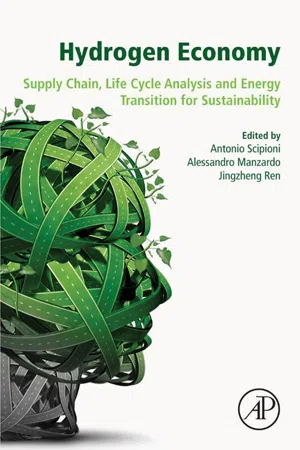
Hydrogen Economy
Supply Chain, Life Cycle Analysis and Energy Transition for Sustainability
Antonio Scipioni,Alessandro Manzardo,Jingzheng Ren
- 328 pages
- English
- ePUB (mobile friendly)
- Available on iOS & Android
Hydrogen Economy
Supply Chain, Life Cycle Analysis and Energy Transition for Sustainability
Antonio Scipioni,Alessandro Manzardo,Jingzheng Ren
About This Book
Hydrogen Economy: Supply Chain, Life Cycle Analysis and Energy Transition for Sustainability explores the challenges for the transition into a sustainable hydrogen economy. In this book, experts from various academic backgrounds discuss the tools and methodologies for the analysis, planning, design and optimization of hydrogen supply chains. They examine the available technologies for hydrogen production, storage, transport, distribution and energy conversion, providing a cross cutting perspective on their sustainability.
Environmental, social and economic aspects are considered, allowing for a more complete life cycle assessment of the entire supply chain. Methods and frameworks for multi-criteria decision making for the sustainable implementation of hydrogen systems are also covered. Providing a broad overview of the subject and well-recognized tools to manage hydrogen sustainability, this book is a useful resource for engineering researchers and PhD students in energy, environmental and industrial areas, energy economy researchers, practicing hydrogen energy engineers and technicians, energy and environmental consultants, life cycle assessment practitioners and consultants.
- Provides a broad perspective of the issues related to environmental, social and economic sustainability of hydrogen energy and its future perspectives
- Presents the current applied research and available tools for managing and assessing hydrogen energy sustainability, such as LCA, optimization, multi-criteria decision making and supply chain optimization
- Explores how experts in the field handle all issues related to the application of life cycle assessment for hydrogen production, storage, transport, distribution and end use
Frequently asked questions
Information
The Role of Hydrogen Energy
Strengths, Weaknesses, Opportunities, and Threats
Abstract
Keywords
1 Introduction
2 SWOT Analysis of Hydrogen Eco...
Table of contents
- Cover image
- Title page
- Table of Contents
- Copyright
- List of Contributors
- Chapter 1. The Role of Hydrogen Energy: Strengths, Weaknesses, Opportunities, and Threats
- Chapter 2. Introduction of Hydrogen Routines
- Chapter 3. Critical Factors and Cause–Effect Analysis for Enhancing the Sustainability of Hydrogen Supply Chain
- Chapter 4. Design and Optimization of Hydrogen Supply Chains for a Sustainable Future
- Chapter 5. Life Cycle Cost Analysis of Hydrogen Energy Technologies
- Chapter 6. Life Cycle Assessment of Solid Oxide Fuel Cells and Polymer Electrolyte Membrane Fuel Cells: A Review
- Chapter 7. Social Life Cycle Assessment of Hydrogen Energy Technologies
- Chapter 8. Comparison of Different Multicriteria Decision-Making Methodologies for Sustainability Decision Making
- Chapter 9. Sustainability Decision Support Framework for the Prioritization of Hydrogen Energy Systems
- Chapter 10. Opportunities and Future Challenges in Hydrogen Economy for Sustainable Development
- Index